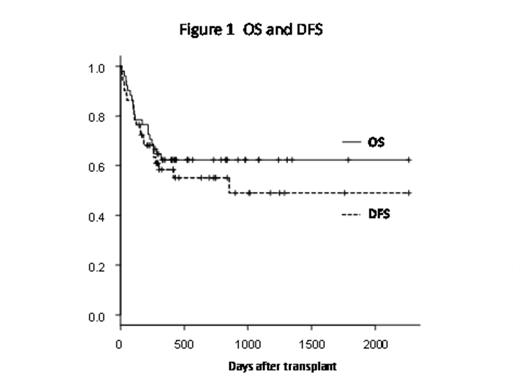Abstract
Although cord blood transplantation (CBT) using reduced-intensity regimens has emerged as an effective therapy for elderly or patients with comorbidities, high relapse rate and non-relapse mortality (NRM) still remain to be resolved. Tointensify antitumor effects without increasing NRM, we have conducted a pilot study of a novel reduced-toxicity myeloablative conditioning for CBT in our institute.
The conditioning consisted of intravenous busulfan 12.8 mg/kg, fludarabine 180 mg/m2 and melphalan 80 mg/m2 followed by single CBT. Fifty-one patients with myeloid malignancies not in remission were included in this study between June 2007 and November 2012. All patients provided written informed consent, andmedical records were retrospectively reviewed.
Their median age was 59 years (range, 19-70), with a median HCT-CI score of 3 (0-6). Underlying diseases were AML in 44, MDS (RAEB-2) in 3, and CML (AP/BC) in 4. All patients were not in remission including primary induction failure (n=19), relapse 1 (14), relapse>2 (7), and untreated (11). Tacrolimus (TAC) plus mycophenolate mofetil were used in 38 cases as GVHD prophylaxis, while TAC alone in 13. All patients received single cord blood unit with 2-mismatches (MM) to the recipient (n=47) and 1-MM (4). The median number of total nucleated cell and CD34+ cells infused at cryopreservation was 2.61 (range, 1.67-5.09) x 107/kg and 0.94 (range, 0.28-2.97) x 105/kg, respectively. Median observation period of survivors was 18.3 (range, 9-75.5) months. Overall survival (OS) and disease free survival (DFS) at 2 years were 62.4% and 55.1%, respectively (Figure 1). Eleven patients relapsed at a median of 5.2 months (range; 0.5-26.7). Cumulative incidences of relapse at 100 days and 2 years were 7.8% and 20.1%, respectively. Cumulative incidences of NRM at 100 days and 2 years were 11.8% and 21.7%, respectively. Causes of NRM were Infection (n=8), GVHD (2) and idiopathic pneumonia syndrome (1). Forty-six out of 51 achieved neutrophil engraftment at median of 19.5 days (range, 13-38) post-transplant, with a cumulative incidence of 90.2%. All patients who achieved engraftment showed complete remission with complete donor chimerism in bone marrow analysis performed at around 30 days post-transplant. Among 5 who failed to achieve neutrophil recovery, 3 experienced early disease progression and 2 died before engraftment, while no patients developed graft rejection. Cumulative incidence of grade II-IV and III-IV acute GVHD were 52.9% and 13.7%, respectively. Of the 42 patients who achieved engraftment and survived longer than 100 days post-transplant, 13 developed limited type of chronic GVHD, and 5 developed extensive type.
This study demonstrated that the novel conditioning regimen using full-dose busulfan and melphalan for CBT provides reliable engraftment without graft rejection and high OS and DFS rates without increasing NRM, even for relatively higher age population with myeloid malignancies not in remission. The promising results using the regimen deserve further evaluation in a multicenter prospective study.
No relevant conflicts of interest to declare.
Author notes
Asterisk with author names denotes non-ASH members.


